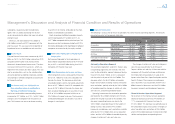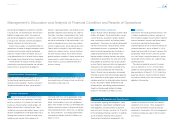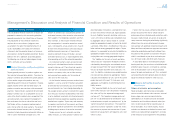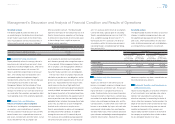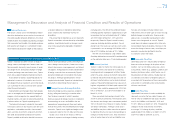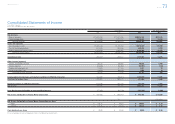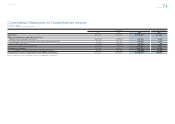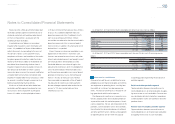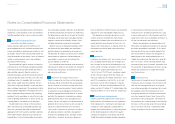Toyota 2013 Annual Report Download - page 71
Download and view the complete annual report
Please find page 71 of the 2013 Toyota annual report below. You can navigate through the pages in the report by either clicking on the pages listed below, or by using the keyword search tool below to find specific information within the annual report.
Toyota Global Vision President’s Message Launching a New Structure Special Feature Review of Operations
Consolidated Performance
Highlights
Management and
Corporate Information Investor InformationFinancial Section
Page 71
NextPrev
ContentsSearchPrint
ANNUAL REPORT 2013
Deferred Tax Assets
The factors used to assess the likelihood of realiza-
tion of the deferred tax assets are the future reversal
of existing taxable temporary differences, the future
taxable income and available tax planning strategies
that are prudent and feasible. All available evidence,
both positive and negative, is considered to deter-
mine whether, based on the weight of that evidence,
a valuation allowance is needed for deferred tax
assets which are not more-likely-than-not to
be realized.
The accounting for deferred tax assets represents
Toyota’s current best estimate based on all available
evidence. Unanticipated events or changes could
result in re-evaluating the realizability of deferred
tax assets.
Management’s Discussion and Analysis of Financial Condition and Results of Operations
Toyota is exposed to market risk from changes in
foreign currency exchange rates, interest rates, cer-
tain commodity and equity security prices. In order
to manage the risk arising from changes in foreign
currency exchange rates and interest rates, Toyota
enters into a variety of derivative fi nancial instruments.
A description of Toyota’s accounting policies for
derivative instruments is included in note 2 to the
consolidated fi nancial statements and further disclo-
sure is provided in notes 20 and 26 to the consoli-
dated fi nancial statements.
Toyota monitors and manages these fi nancial expo-
sures as an integral part of its overall risk management
program, which recognizes the unpredictability of
fi nancial markets and seeks to reduce the potential-
ly adverse effects on Toyota’s operating results.
The fi nancial instruments included in the market
risk analysis consist of all of Toyota’s cash and cash
equivalents, marketable securities, fi nance receiv-
ables, securities investments, long-term and short-
term debt and all derivative fi nancial instruments.
Toyota’s portfolio of derivative fi nancial instruments
Quantitative and Qualitative Disclosures about Market Risk
consists of forward foreign currency exchange con-
tracts, foreign currency options, interest rate swaps,
interest rate currency swap agreements and interest
rate options. Anticipated transactions denominated
in foreign currencies that are covered by Toyota’s
derivative hedging are not included in the market
risk analysis. Although operating leases are not
required to be included, Toyota has included these
instruments in determining interest rate risk.
Foreign Currency Exchange Rate Risk
Toyota has foreign currency exposures related to
buying, selling and fi nancing in currencies other
than the local currencies in which it operates.
Toyota is exposed to foreign currency risk related to
future earnings or assets and liabilities that are
exposed due to operating cash fl ows and various
fi nancial instruments that are denominated in foreign
currencies. Toyota’s most signifi cant foreign curren-
cy exposures relate to the U.S. dollar and the euro.
Toyota uses a value-at-risk analysis (“VAR”) to
evaluate its exposure to changes in foreign currency
exchange rates. The VAR of the combined foreign
exchange position represents a potential loss in pre-
tax earnings that was estimated to be ¥87.9 billion
and ¥99.1 billion at March 31, 2012 and 2013,
respectively. Based on Toyota’s overall currency
exposure (including derivative positions), the risk
during fi scal 2013 to pre-tax cash fl ow from curren-
cy movements was on average ¥99.1 billion, with a
high of ¥129.5 billion and a low of ¥78.1 billion.
The VAR was estimated by using a Monte Carlo
Simulation Method and assumed 95% confi dence level
on the realization date and a 10-day holding period.
Interest Rate Risk
Toyota is subject to market risk from exposures to
changes in interest rates based on its fi
nancing,
investing and cash management activities. Toyota
enters into various fi nancial instrument transactions
to maintain the desired level of exposure to the risk
of interest rate fl uctuations and to minimize interest
expense. The potential decrease in fair value result-
ing from a hypothetical 100 basis point upward shift
in interest rates would be approximately ¥144.2 bil-
lion as of March 31, 2012 and ¥208.5 billion as of
March 31, 2013.
There are certain shortcomings inherent to the
sensitivity analyses presented. The model assumes
that interest rate changes are instantaneous parallel
shifts in the yield curve. However, in reality, changes
are rarely instantaneous. Although certain assets
and liabilities may have similar maturities or periods
to repricing, they may not react correspondingly to
changes in market interest rates. Also, the interest
rates on certain types of assets and liabilities may
fl uctuate with changes in market interest rates,
while interest rates on other types of assets may lag
behind changes in market rates. Finance receiv-
ables are less susceptible to prepayments when
interest rates change and, as a result, Toyota’s
model does not address prepayment risk for auto-
motive related fi nance receivables. However, in the
event of a change in interest rates, actual loan pre-
payments may deviate signifi cantly from the
assumptions used in the model.
Commodity Price Risk
Commodity price risk is the possibility of higher or
lower costs due to changes in the prices of com-
modities, such as non-ferrous alloys (e.g., alumi-
num), precious metals (e.g., palladium, platinum and
rhodium) and ferrous alloys, which Toyota uses in
the production of motor vehicles. Toyota does not
use derivative instruments to hedge the price risk
associated with the purchase of those commodities
and controls its commodity price risk by holding
minimum stock levels.
Equity Price Risk
Toyota holds investments in various available-for-
sale equity securities that are subject to price risk.
The fair value of available-for-sale equity securities
was ¥1,034.3 billion as of March 31, 2012 and
¥1,401.1 billion as of March 31, 2013. The potential
change in the fair value of these investments,
assuming a 10% change in prices, would be
approximately ¥103.4 billion as of March 31, 2012
and ¥140.1 billion as of March 31, 2013.
Selected Financial Summary (U.S. GAAP) Consolidated Segment Information Consolidated Quarterly Financial Summary Management’s Discussion and Analysis of Financial Condition and Results of Operations [26 of 26] Consolidated Financial Statements Notes to Consolidated Financial Statements
Management’s Annual Report on Internal Control over Financial Reporting Report of Independent Registered Public Accounting Firm



